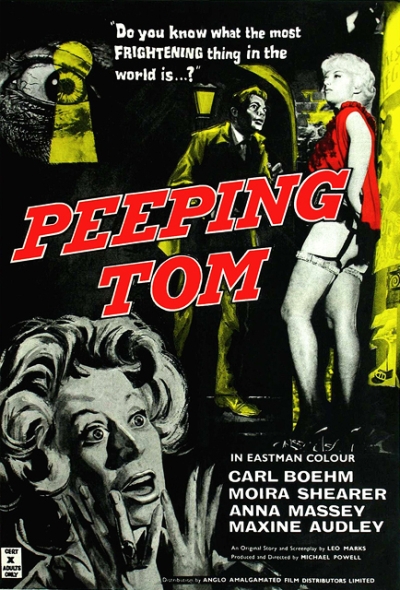
(Update: The original playlist is gone, but you can still watch the whole thing here, courtesy of Lionsgate.)
It’s Good Friday today, the celebration of that penultimate event that preceded the most important of Christian miracles. In the spirit of this solemn occasion the Friday Afternoon Movie presents the story of a serial killer who impales his victims with a spike mounted to his video camera’s tripod. Happy Easter!
Released to intense controversy, Michael Powell’s brilliant Peeping Tom from 1960 is a film whose reputation has undergone a renaissance in the ensuing decades, starting in the 1970s. Martin Scorsese, in the book Scorsese on Scorsese, paired it with Fellini’s 8½ as a complete education in directing, saying:
I have always felt that Peeping Tom and 8½ say everything that can be said about film-making, about the process of dealing with film, the objectivity and subjectivity of it and the confusion between the two. 8½ captures the glamour and enjoyment of film-making, while Peeping Tom shows the aggression of it, how the camera violates… From studying them you can discover everything about people who make films, or at least people who express themselves through films.
Such effusive praise aside, Powell made a fantastic picture, one that manages to match the suspense of his contemporary, Alfred Hitchcock whose classic Psycho was released in June of that year, a mere three months after Peeping Tom.
The story of Peeping Tom is a simple one. Mark Lewis is a quiet man who works on a film crew, with aspirations of becoming a filmmaker. To supplement his income he also takes racy photos of women. He lives in a house willed to him by his father and rents out part of it while he poses as a tenant. He slowly becomes interested in Helen, who lives below him with her blind, alcoholic mother. Mark also likes to kill women with the aforementioned tripod, filming them as he is doing so. The explanation for this particular psychosis is that Mark’s father was a prominent psychologist who made his reputation by constantly harassing and terrifying his young son in order to better understand the psychology of fear, all the while filming his reactions, going so far as to wire all the rooms in the house.
To contemporary audiences this is all very old hat but again, at the time it was scandalous. The racier version of a scene with Pamela Green, in which one whole breast is exposed for two whole seconds, is credited with being the first nude scene in a major British feature, but even the cut version of this did nothing to silence the outcry. People were appalled of the idea of camera as weapon almost as much as they were by the fact that Powell cast himself as Mark’s psychologist father with his own son playing the role of Mark as a child, and the backlash effectively ended Powell’s career in the UK. A movie that can be read as an implication of its audience as voyeurs and the directors of horror films as psychotic killers, terrorizing the innocent for entertainment it was perhaps ahead of its time. The reevaluation of Peeping Tom is well deserved and Powell deserves all the recognition he can get.







